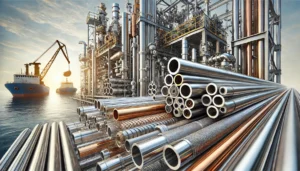“Ever thought about what maintains the smooth circulation of water, gas, and oil through our cities and inside our walls? The answer lies within something small and usually neglected: pipe fittings. At every pipeline system, they are more than mere connectors, they help manage the efficient and safe transport of fluids and gases.”
Pipe fittings, regardless of what industry it is, be it plumbing, oil and gas, construction or manufacturing, requires selection with the utmost intention. The piping system and its efficiency, integrity, safety and maintenance cost is significantly affected by the choice of fittings. Despite being small, each fitting has the potential to unlock a seamless operation propelling selection beyond mere size and type to a systematic decision.
Selecting the Optimal Material for Pipe Fittings: A Guide for Industry Professionals
Choosing the pipe fittings for any industrial job requires care. Material selection is like choosing the right tool for the job. The fitting’s performance, life-expectancy, and versatility are dictated by the material choice which makes it suited for a specific environment. Following is a more precise overview of the most popular materials:
- PVC (Polyvinyl Chloride): It is best suited for low-temperature applications. Cold water transport is best done via PVC tubing. Its resistance to chemical corrosion makes it suitable for waste and vent systems. However, as fluids get hotter, PVC becomes unsuitable too since it warps and degrades under high temperatures.
- Brass: An alloy of copper and zinc, Brass is highly heat resistant making it a preferred option for hot water systems and other high temperature dealing applications. When it comes to durability, brass excels and is widely used where corrosion resistance is the primary requirement, for instance, marine environments.
- Stainless Steel: Stainless steel is well-liked for its strength and resistance to corrosion, making it a one size fits all option for many different conditions. It is quite proficient at harsh scenarios because it withstands rust and corrosion even in the presence of chemicals and saline solutions. Thus, bolting stainless steel fittings is a dependable choice in oil and gas industries, as well as at chemical processing plants.
When piping systems are designed, relevant issues concerning temperature, pressure, chemicals, environmental conditions, and materials must be considered for optimum performance. Choosing the wrong material can result to issues like material failure, leaking pipes, or even damage threatening the safety of others. In these cases, due planning minimizes the risk of compromising safety or industry standards and also guarantees longevity and effectiveness of the piping system.
Knowledge of these properties, with material selection relevant to each industrial application, leads to making the right decision for optimal safety and performance concerning a company’s safety and operational needs.
Specifications: Size, Shape, and Standards
Let’s discuss the magnitudes, geometry of the object, and advocacy. Picture attempting to put a square plug into a round hole; it simply doesn’t function. This is analogous to pipes and pipe fittings also having to get the correct parameters of dimension and geometry. For proper functioning, they need to be of a certain size and shape. If you go too large, or too small, problems like leaks, or blockages will occur.
In addition, it is much the same as striving to follow a recipe that you have been given; in this case it’s about the right ingredients the pipe fittings require are industry standards, and specifications. It is about rules policies which enable fittings to be safe and functional. It instructs what values to be used like the radius, diameter and shapes of things. Observing these regulations enables you to avoid piping system failures.
Pipette Types and Their Specified Industrial Functions
A comprehensive understanding of pipe fittings and their applications is fundamental for project supervisors and industrial managers. Thus, here’s an overview of some popular pipe fittings and their functions in industrial applications:
- Elbows: These fittings allow for a change in direction of flow in pipe lines. Elbows are critical in intricate designs where pipes must circumvent spatial constraints or switch directions for ideal positioning. They are also available in multiple angles like 90 and 45 degrees to enhance system design. In industries, elbows are utilized extensively to ensure continuous flow in pipes which are required to adapt with the structural layout of buildings, whether they are in power generation plants, manufacturing plants, or other processing plants.
- Unions: Unions are meant for ease since it provides effortless separation and joining back of the limbs of the pipe. This is very useful in industrial systems where machines or parts of pipe systems need regular servicing or changing of parts. For example, in cleaning or servicing a certain segment of a pipe in a chemical processing plant, unions make it possible without dismantling the whole system.
- Reducers: They serve as the connections between pipes of differing diameters and maintain a consistent flow rate as well as pressure change. Critical in cases when the pipe has to be changed due to differing flow needs, or to connect equipment of varying sizes, reducers are vital in systems where the piping needs to be changed due to flow requirements. In water treatment or oil refining industries, the use of diverging reducers helps interconnect different machines and piping designs while maintaining operational integrity.
Every piping professional involved in managing complex industrial projects needs to know this information regarding these fittings so as to design efficient, reliable and safe piping systems. Each fitting type serves a distinct purpose, and their correct usage can significantly impact the functionality and maintenance needs of industrial piping networks.
Beyond Cost: Why Cheaper Isn’t Always Better
Focusing solely on the price of purchase of pipe fittings can be quite detrimental. Switching from one set of fittings to another just to save money seems like a plan on paper, but in reality, it’s equivalent to buying a flimsy umbrella that doesn’t stand a chance in a storm.
Buying more expensive fittings even just once might yield significant savings in the future. Here’s how:
- Durability: Better materials and craftsmanship make quality fittings durable. Their cheaper counterparts do not last as long and need replacing more frequently which results in spending more money over time.
- Fewer Leaks and Breakage: High-end fittings are less probable to be defective or breaking. Repair for faulty fittings, along with the increased water bills and potential water damage due to leaks, can become very pricey. If better fittings are used, chances of these expensive problems are mitigated.
- Reduce Maintenance: Less maintenance is needed with better fittings hence, savings can be made. Time and effort along with money are saved from having to carry out regular repairs.
- Safety: Improper safety standards may be overlooked when it comes to cheaper fittings which can endanger the system and the people surrounding it. Anything high-quality would be made taking into consideration all safety measures ensuring the utmost safety for everyone.
- Efficiency: With high-quality fittings, every piping system works as efficiently as it can. This heightened efficiency could also save you money, since the system would not have to expend energy to pump or heat water in the pipes.
- Long Term Value: Although the initial installation cost of fittings is significantly higher, the quality fittings will require less maintenance and last longer, thus giving you more value over time. This will ultimately pay off in the long run.
- Peace of Mind: This benefit cannot be measured by price or anything of monetary value, but it is priceless: the certainty and assurance that comes with knowing your system is integrated with dependable fittings brings a sense of calm and security.
Industry Standards and Compliance: Safety First
These standards serve as guidelines for every other component of pipe fittings that require accuracy, dependability, and safety. It is just like writing the blueprints for a house; all the components and their roles have to work according to different variables, and fit safely.
Regarding pipe fittings, standards like ASTM (American Society for Testing and Materials) and ISO (International Organization for Standardization) are of utmost importance. It includes everything from material selection to the manufacturing process of the fittings. Just like following a recipe ensures the desired outcome, adhering to these standards guarantees safety and quality, avoiding potential dangers.
Tailoring to Your Needs: A Buyer’s Checklist
Are you selecting the most appropriate pipe fittings? The following checklist may assist you:
- Material: Match the material to the job. Is it for water, gas, or something else?
- Size and Shape: Make sure they fit like puzzle pieces.
- Standards: Check if they meet ASTM, ISO, or other necessary standards.
- Type: Pick the right type (elbow, union, reducer) for the task.
- Quality Over Cost: Remember, cheaper isn’t always better in the long run.
- Safety and Reliability: Ensure they’re safe and reliable for your specific use.
Each purchase requires careful attention and thought. The same principles underlying safety and proper resource allocation can also be applied, just like trying to avoid using dubious ingredients in a successful recipe.
Conclusion: Fitting It All Together and Looking Ahead
The connection of a smaller pipe fitting should also be considered carefully as this relates to all the vital components of both residential and industrial piping systems. The selection of materials and types of fittings along with compliance to set regulations is crucial. These details inform the construction’s safety and efficiency. The system’s reliability and effectiveness, along with operational efficiency, using an appropriate stuffing box should not solely be regarded as a purchase, but instead appertain to strategic decision planning.
Towards the end of this conversation, don’t forget that the domain of pipe fittings is rapidly changing with technologies and manufacturing methods yet to be discovered. Wait for our next blog, “Innovative Manufacturing Insights: The Precision Process of Pipe Fitting at Induskart,” where we will discuss the processes and artistry that accompany best pipe fitting production. This forthcoming discussion will show a new side to how precision manufacturing is done, industrial piping, and the future with new advanced developments undergoing changes. This is one of the most exciting observations regarding precise and competently crafted pipe fittings that one should look forward to. Thank you for reading!









